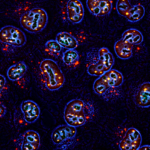Link to Pubmed [PMID] – 1375840
Blood 1992 Jun;79(12):3110-5
The t(15;17) translocation is specifically observed in patients with promyelocytic leukemia (AML3). The chromosomal rearrangement juxtaposes the retinoic acid receptor alpha (RAR alpha) and PML genes, resulting in PML/RAR alpha fusion transcripts. Our previous studies have shown that a polymerase chain reaction (PCR) amplification product could be obtained from the cDNA of the NB4 promyelocytic cell line from which the chimaeric PML/RAR alpha was cloned. We report here that in all 14 AML3 patients tested, reverse transcriptase-PCR (RT-PCR) allows the detection of three specific fusion products. In eight patients, one amplification product was detected corresponding to the previously described abnormal fusion. Five patients displayed a different amplified fragment corresponding to a different fusion point. One other patient always showed a third different-sized product. The different types of fusion transcripts amplified were correlated to the size of the abnormal RAR alpha transcripts detected in these patients by Northern analysis, but did not prove determinant for either the phenotypic features or the retinoic acid responsiveness in AML3 cells in this group of patients. The consistent identification by RT-PCR of the fusion of the PML and RAR alpha genes in AML3 patients suggest that this method will provide a useful tool for the diagnosis and detection of minimal residual disease in these patients.

